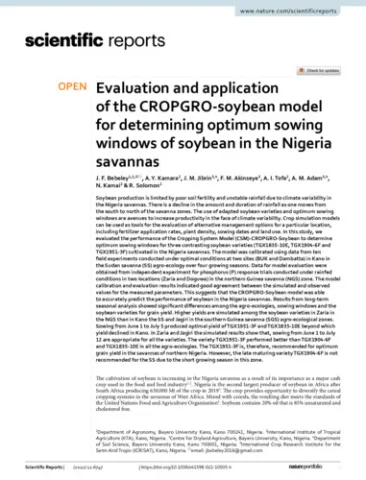Evaluation and application of the CROPGRO-soybean model for determining optimum sowing windows of soybean in the Nigeria savannas

Abstract
Soybean production is limited by poor soil fertility and unstable rainfall due to climate variability in the Nigeria savannas. There is a decline in the amount and duration of rainfall as one moves from the south to north of the savanna zones. The use of adapted soybean varieties and optimum sowing windows are avenues to increase productivity in the face of climate variability. Crop simulation models can be used as tools for the evaluation of alternative management options for a particular location, including fertilizer application rates, plant density, sowing dates and land use. In this study, we evaluated the performance of the Cropping System Model (CSM)-CROPGRO-Soybean to determine optimum sowing windows for three contrasting soybean varieties (TGX1835-10E, TGX1904-6F and TGX1951-3F) cultivated in the Nigeria savannas. The model was calibrated using data from ten field experiments conducted under optimal conditions at two sites (BUK and Dambatta) in Kano in the Sudan savanna (SS) agro-ecology over four growing seasons. Data for model evaluation were obtained from independent experiment for phosphorus (P) response trials conducted under rainfed conditions in two locations (Zaria and Doguwa) in the northern Guinea savanna (NGS) zone. The model calibration and evaluation results indicated good agreement between the simulated and observed values for the measured parameters. This suggests that the CROPGRO-Soybean model was able to accurately predict the performance of soybean in the Nigeria savannas. Results from long-term seasonal analysis showed significant differences among the agro-ecologies, sowing windows and the soybean varieties for grain yield. Higher yields are simulated among the soybean varieties in Zaria in the NGS than in Kano the SS and Jagiri in the southern Guinea savanna (SGS) agro-ecological zones. Sowing from June 1 to July 5 produced optimal yield of TGX1951-3F and TGX1835-10E beyond which yield declined in Kano. In Zaria and Jagiri the simulated results show that, sowing from June 1 to July 12 are appropriate for all the varieties. The variety TGX1951-3F performed better than TGX1904-6F and TGX1835-10E in all the agro-ecologies. The TGX1951-3F is, therefore, recommended for optimum grain yield in the savannas of northern Nigeria. However, the late maturing variety TGX1904-6F is not recommended for the SS due to the short growing season in this zone.
